Cleaning Up Colorado's Biggest Fire
How Businesses, Government, and Individuals Come Together
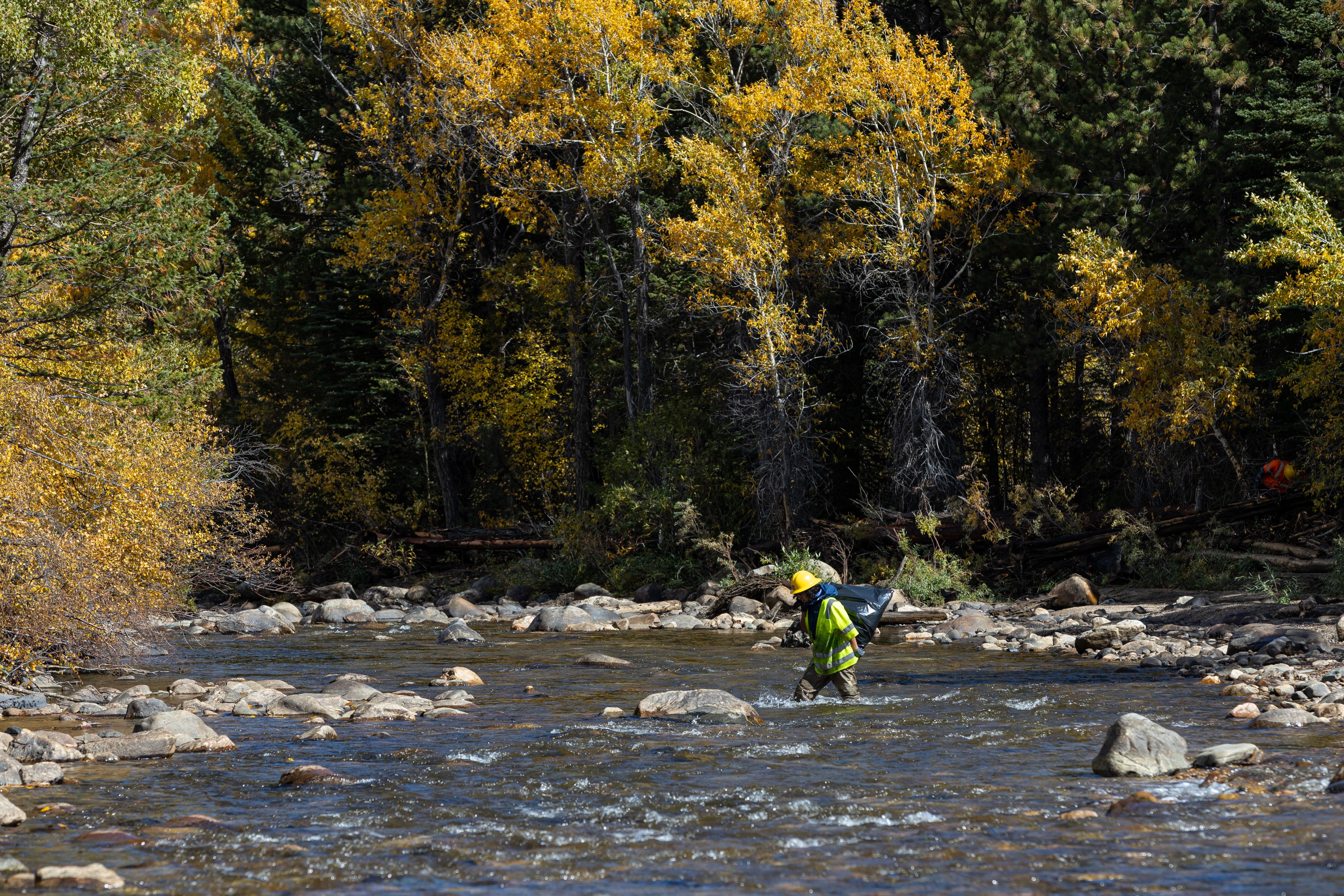
While summer came to a close, inviting the fall foliage and brisk weather, 61 members of the Northern Colorado community, all with unique backgrounds, came together on the Cache la Poudre River, 40 miles west of Fort Collins. The river was filled with a plethora of debris, ranging from remnants of a dryer, brick walls still intact, to items like briefcases and other personal items.
The task at hand for those who came was to help clear debris washed into the river by the Black Hollow Flood on July 20 that sent six houses into the river and claimed four souls. The group of volunteers were brought together by numerous organizations, one of those being Rocky Mountain Flycasters Trout Unlimited (RMFTU). RMFTU a non-profit organization whose mission is to conserve and protect the Poudre and Big Thompson watersheds. The entire operation was overseen by the U.S Forest Service, but wouldn’t have been possible without the help of the numerous organizations who spread the word.
One battle RMFTU and other local disaster relief organizations are fighting is the increased likelihood of flooding due to large wildfires. On top of that is this particular floods impact on the fish populations in the river, which early numbers suggest has taken a big hit. The culprit behind the Black Hollow Flood was the largest wildfire in the history of Colorado, the 2020 Cameron Peak Fire.
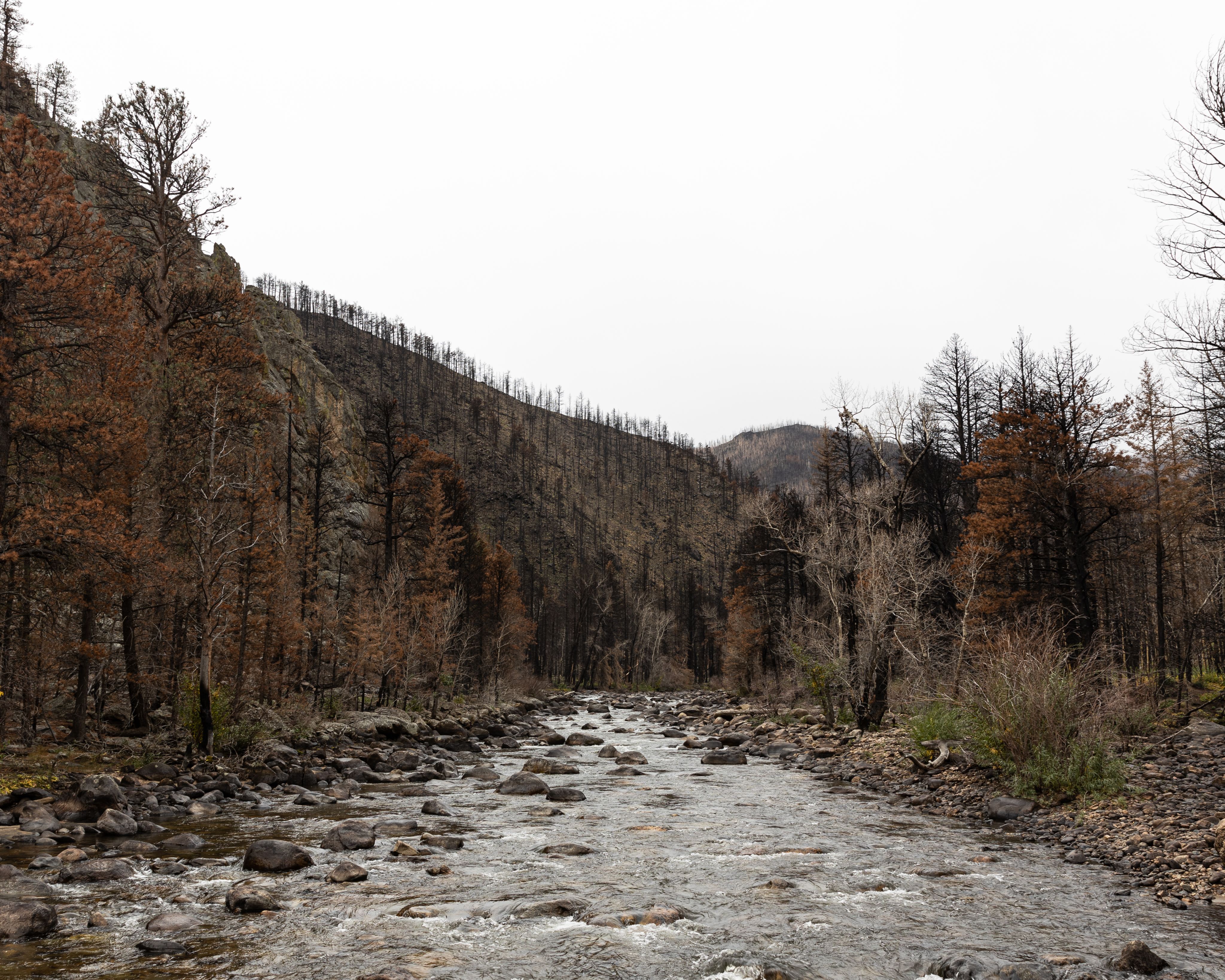
The Cameron Peak burn scar up stream of where volunteers were working in the Poudre River, Saturday, Oct. 9, 2021. (Harry Fuller, CU News Corps)
The Cameron Peak burn scar up stream of where volunteers were working in the Poudre River, Saturday, Oct. 9, 2021. (Harry Fuller, CU News Corps)
The Deep Impact
The fire began on Aug. 13, 25 miles east of Walden, a small northern Colorado town with a population of less than 600 people. The fire burned over 78,00 acres in the span of three days in early September, where it grew to over 100,00 acres. After another rapid growth in mid-October, the fire became the first in Colorado history to surpass 200,000 acres burned. Fires like the Cameron Peak Fire are becoming more frequent, and large fires lead to an increased probability of flooding.
Forest fires increase the likelihood of flooding for multiple reasons. In simple terms, fires destroy vegetation, and the lack of vegetation leads to the hillsides having no defense against heavy precipitation. This means that due to the lack of treetops, roots, and other protection, burn scar soil is more susceptible to quick movement. Burnt soil is not as compact as soil in a section of forest with trees and other vegetation. In fact, these floods may occur with average amounts of precipitation due to lack of stability the soil has. Because of this, these areas are more at risk of landslides and ultimately, flooding.
“I’ve never seen anything like this,” said Sarah King from the Colorado Addicted Trailbuilders Society referring to her experience with the fallout of the Black Hollow Flood.
“I’ve been living in mountain states for a long time, and I would describe this as unsettling." King said. "It’s weird to be going through people’s stuff and finding it in the river.”
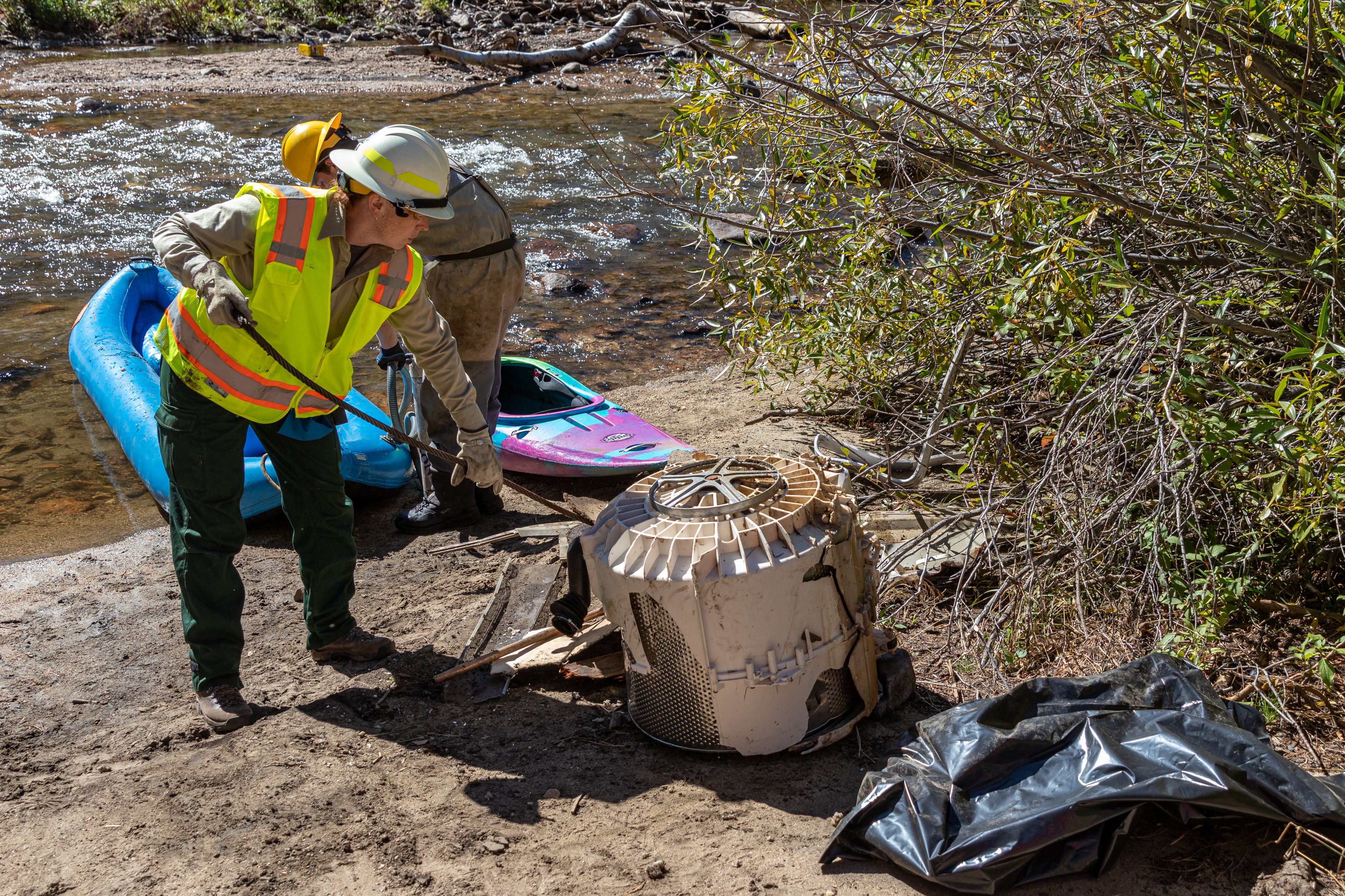
A volunteer working with debris at a cleanup of the Poudre River that was coordinated by the U.S. Forest Service, Saturday, Sep. 25, 2021. (Max Nelson, CU News Corps)
A volunteer working with debris at a cleanup of the Poudre River that was coordinated by the U.S. Forest Service, Saturday, Sep. 25, 2021. (Max Nelson, CU News Corps)
Scattered remains of the houses can be found all throughout the river. Many of them being personal and household belongings, one being the well of a washer machine. Many items were a constant reminder to volunteers that these were the remains of where people once lived.
Personal belongings weren’t the only thing washed into the river. Runoff from the burn scar washed a large amount of ash and sediment into the river. People as far as 40 miles down the river from the flood reported the Poudre running black. The water quality was degraded so much that Fort Collins was forced to stop using the Poudre as a water source. Luckily, these challenges are being addressed by local businesses and organizations.
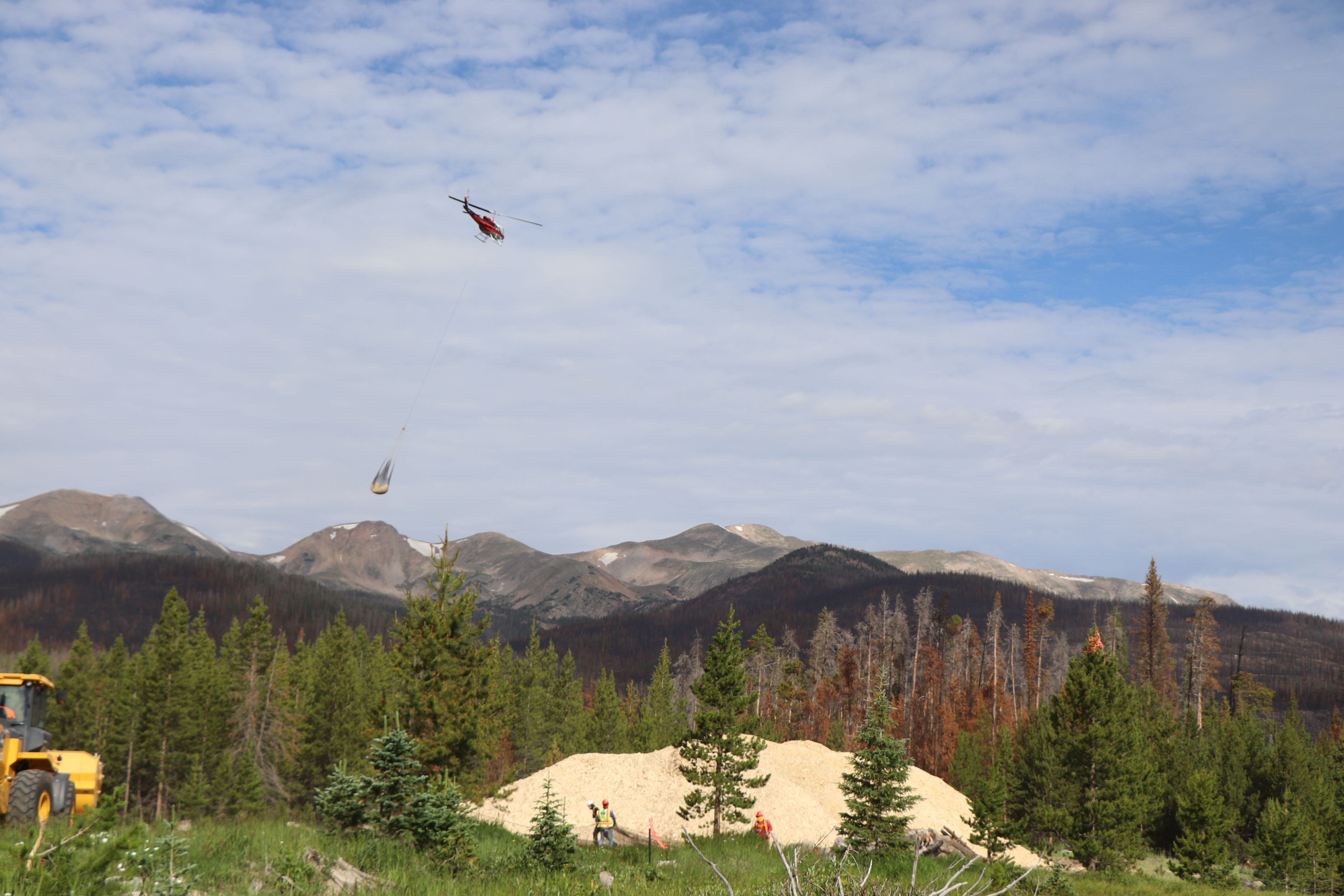
A helicopter flying to drop mulch on the Cameron Peak Burn Scar. (Photo provided by the Coalition for the Poudre River Watershed)
A helicopter flying to drop mulch on the Cameron Peak Burn Scar. (Photo provided by the Coalition for the Poudre River Watershed)
Uniting the Stakeholders
The Coalition for the Poudre River Watershed (CPRW) is a nonprofit dedicated to maintaining the health and longevity of the Poudre River Watershed and has been one of the major organizations coordinating recovery efforts between the city of Fort Collins, the city of Greely, the U.S. Forest service and many others. CPRW made connections and gained its initial post-fire experience while working on restoration projects after the High Park Fire in 2012.
The Cameron Peak Fire’s large burn footprint meant that many different types of land owners across multiple cities and counties were affected. In order to make the biggest impact, businesses and nonprofits stepped in to help coordinate recovery efforts between the different stakeholders.
“A benefit of having a nonprofit like ours help coordinate efforts in the watershed is you’re more easily able to cross those boundaries and work across land ownership types” Shayna Jones, the post-fire mitigation and recovery program manager for CPRW said.
They began fundraising for restoration efforts within 10 days of the Cameron Peak Fire’s ignition. With over 200,000 acres burned, significant resources were required to provide any widespread results. Using funds from grants, local donors, businesses, county, state, and federal agencies, the coalition raised over $11 million and started several different restoration projects with other businesses and government organizations. Those projects include aerial mulching, community outreach to teach land-owners restoration techniques, and planting trees in the burn scar area to encourage reforestation.
“Everybody has access to slightly different resources," Jones said. "So the nice thing about these collaborative efforts is that you're trying to leverage what people can do and what resources they have for the bigger picture.”
The coalition’s biggest undertaking so far has been with government agencies on the state and federal levels to start aerial mulching. Sometimes referred to as straw bombing, aerial mulching is a process where helicopters drop straw or wood shreds onto burned areas to help maintain soil moisture, prevent erosion, and promote new vegetation growth. As of Sep. 15, the coalition has completed mulching over 5,000 acres of land, and will continue to mulch high priority areas again in 2022.

A front loader in front of a pile of mulch near the Cameron Peak Burn Scar. (Photo provided by the City of Greeley)
A front loader in front of a pile of mulch near the Cameron Peak Burn Scar. (Photo provided by the City of Greeley)
For the remainder of the fall, the CPRW will continue smaller restoration projects with hand crews to prevent any extra erosion they can. Although weather will make most projects stop for the winter, the CPRW won’t be taking any time off. Their post-fire mitigation and recovery team will use the winter months to review their progress and decide what changes might need to be made in their plan for next year. It still needs to be seen what snowmelt and rainfall will do in the Spring of 2022, but the CPRW will march ahead despite that uncertainty.
“We think with this first year of really heavy work out of the way, the community input and participation will only increase for the next couple years as we continue to see what types of impacts we’re going to get specifically on the ground,” Jones said.
Although post-fire work is an important component of CPRW’s work, they also have members working on the other side of the equation: stopping wildfires before they start. Or, more accurately, shaping up forests so that when the inevitable happens, wildfires won’t burn to the scale of Cameron Peak.
“A century of fire suppression, climate change, and land use practices in the past have caused our forests to get way denser,” Daniel Bowker, CPRW’s forest and fire project manager said. “Fires are burning in a way that we don’t want them to and in a way that they didn’t burn a hundred years ago.”
Using resources from CPRW, Bowker gets in contact with private landowners in critical parts of the Poudre Watershed and helps educate them about what changes they could make to improve the forest conditions in their property. He said that oftentimes the U.S. Forest Service will be doing work on their side of the fence, but to maximize the effects of any pre-fire work, extending that work onto private land is important. Whether it's changing the makeup of trees on their property or just collecting pine needles and fallen branches into piles, working with landowners is critical.
As with post-fire work, there are many different tactics that can be used before fires begin that can reduce their impact. Some of these tactics such as slash pile burning or prescribed fires include burning fuel off of the forest floor, similar to what a forest fire might do, but in a smaller and more controlled manner. Bowker noted that CPRW’s community outreach efforts have been very useful in these projects as well.
“We didn’t get any negative feedback this year on pile burning which is kind of unheard of,” Bowker said. “Normally somebody is going to say you guys are crazy for burning stuff in the woods.”
By unifying the efforts of all the different stakeholders involved with fires, CPRW tries to maximize the benefits of all their projects in the watershed. Their work even goes beyond just the Poudre Watershed with their involvement in the Northern Colorado Fireshed Collaborative and plays a part in a much larger endeavor to increase the effectiveness of fire-mitigation work along the northern parts of the front range in Colorado.
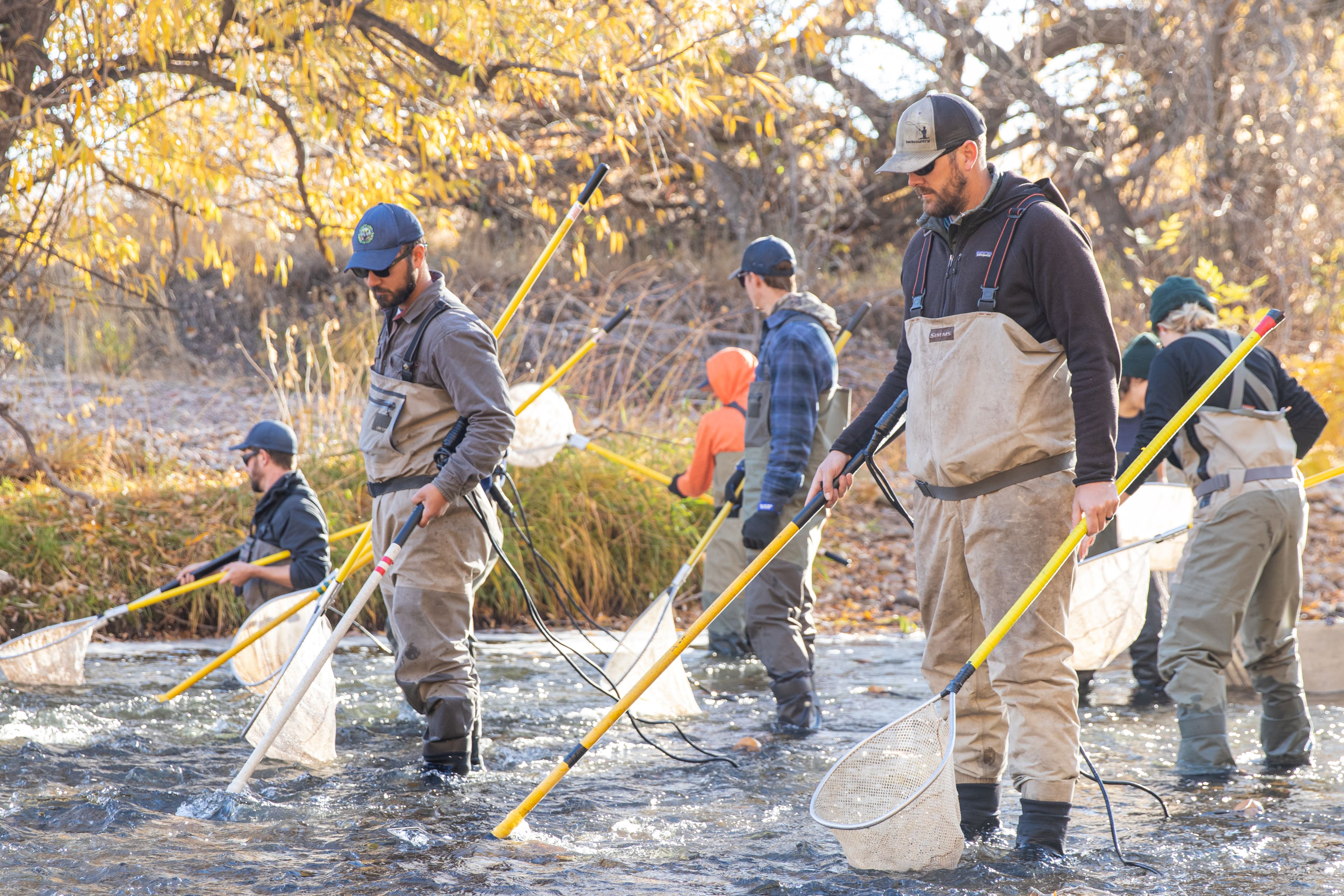
Kyle Battige (left) and Chris Carrol (right) working with volunteers to electro-fish for the CPW Fish Survey, Friday, Oct. 29, 2021. (John Schauer, CU News Corps)
Kyle Battige (left) and Chris Carrol (right) working with volunteers to electro-fish for the CPW Fish Survey, Friday, Oct. 29, 2021. (John Schauer, CU News Corps)
Surveying the Damage
Different government entities oversee different aspects of the environment where The Cameron Peak Fire burned and the land the Black Hollow Flood destroyed. Federal and state agencies, along with city governments tackle different parts of the recovery process following natural disasters like these. With much of the burned area being U.S. Forest Service land, they have taken an active role in working with volunteers and businesses to help get the restoration work started. The Colorado Parks and Wildlife or CPW has been more focused on gathering data and evaluating the impacts that the fire and flood had on the wildlife and their habitat.
Every year, aquatic biologists from CPW conduct surveys in their respective regions and river basins to compare to historical data and evaluate the conditions in rivers, decide how many fish should be stocked in an area and make any changes to fishing regulations that may be required.
CPW collects data on fish populations by electro-fishing on a stretch of a river in two different passes to try and catch all the fish in that section of the river. Using the amount of fish they catch in the different data collection sites, biologists can estimate the number of fish per mile in a river. Although data for the Poudre River is still being collected, the first look at the fishery near Black Hollow Canyon looks grim.
“We sampled at Kelly Flats 10 miles downstream and we caught zero fish.” Kyle Battige, an aquatic biologist for CPW said. “In 2020 we caught 155 fish on our first pass and 28 on the second pass and that yielded a population estimate of 1845 trout per mile over 6-inches and right now our estimate is zero.”
Despite the rough start to their survey of the Poudre, Battige said that a stretch of river surveyed above Black Hollow Canyon did have fish, but it appeared that runoff from the Cameron Peak Burn Scar has reduced the population. Further downstream from where the Black Hollow Flood occurred, fishermen have said that they haven’t noticed a change in the number of fish, so the effects of the fire and flood appear to mostly be in the upper canyon.

A fish being measured at a CPW survey to estimate the population of fish in the Poudre River, Friday, Oct. 29, 2021 (John Schauer, CU News Corps)
A fish being measured at a CPW survey to estimate the population of fish in the Poudre River, Friday, Oct. 29, 2021 (John Schauer, CU News Corps)
Due to the uncertainty of the amount of runoff expected in the Spring of 2022, Battige couldn’t specify how CPW will react to the effects of the Cameron Peak Fire, but said that stocking fish to jump-start the river is a possibility. The current fishing regulations vary depending on where you are on the Poudre, but Battige expects that fishing regulations in the Poudre Canyon to remain unchanged.
“The one thing we generally see from our creel surveys interviewing anglers in the canyon, is that they’re not keeping a ton of fish,” Battige said.
Fishermen aren't the only people concerned about the health of the river. Whether they were Colorado State University students, avid kayakers, or hikers, everyone that was present at the cleanups has a personal connection to the Poudre.
Volunteer Schyler King worked for 12 years as a water guide on the Poudre, but is now a civil engineer in Fort Collins. King said that he was there because having this type of debris is just hazardous to all kayakers.
Sarah King, a volunteer with the Colorado Addicted Trailbuilders Society (CATS) said that these sort of events are on the rise and can happen at any moment, to anyone. King said that it's unusual for CATS to be working on a project like this. Her organization usually deals with making trails, not pulling houses out of rivers.
“We have the tools to do this, so that’s a big plus, but I’ve never done this, we move big rocks,” she said. “It definitely seemed like it was a first for everyone.”

Volunteers carrying a large piece of steel across the Poudre River, Saturday, Oct. 9, 2021. (Harry Fuller, News Corps)
Volunteers carrying a large piece of steel across the Poudre River, Saturday, Oct. 9, 2021. (Harry Fuller, News Corps)
It wasn’t easy work either, as plenty of debris was stuck on the other side of the river. Whether it was steel beams, large planks of wood, or kitchen appliances, all of it had to be brought across the river on foot or by a pulley system.
The big ticket item that needed removal from the river was a propane tank. The kind that mountain residents rely on to heat their homes during the cold and bitter Colorado winters. It was so massive that volunteers needed help from a U.S. Forest Service truck to pull it out of the river.
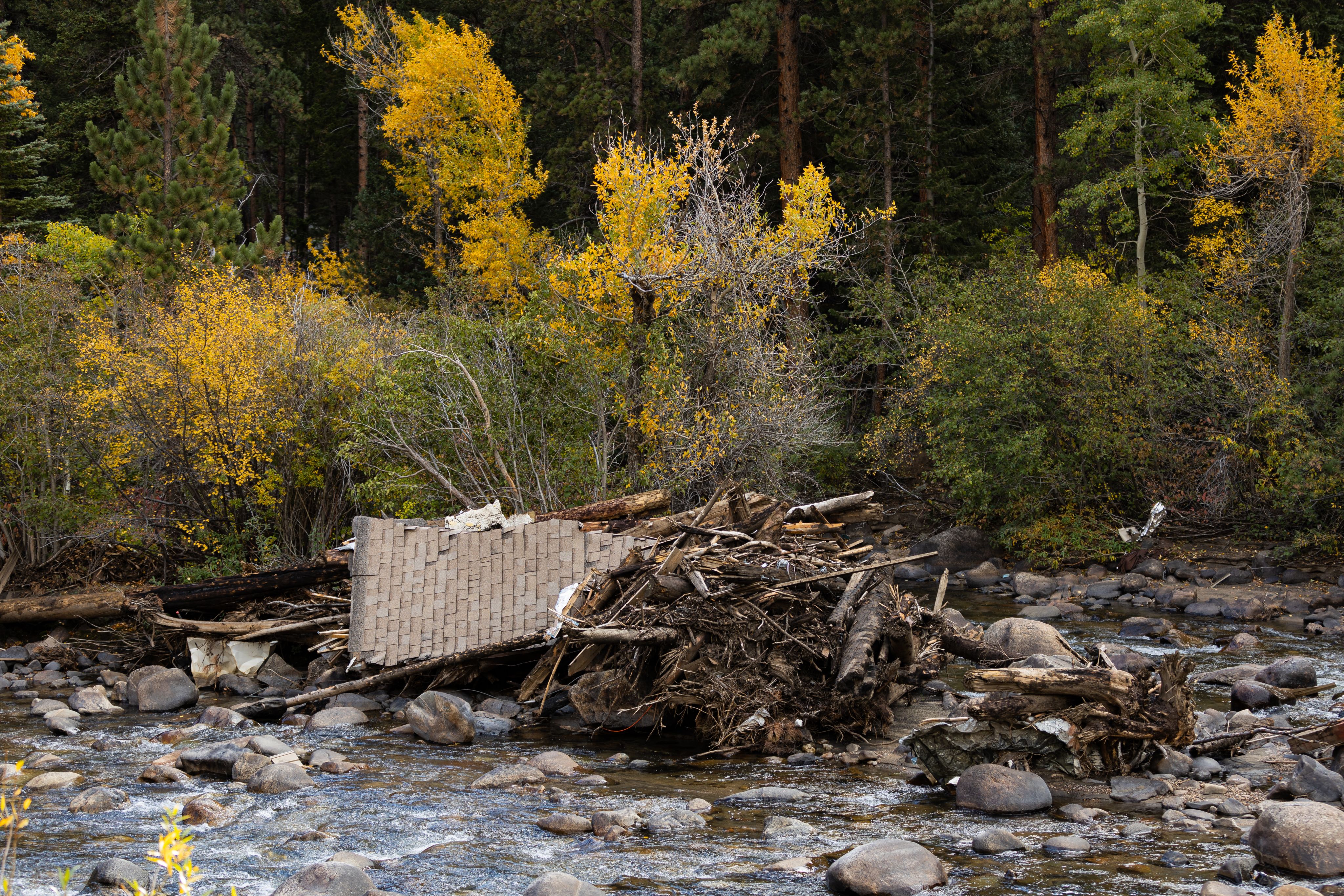
Wreckage from the Black Hollow Flood that was between the areas volunteers were working with the U.S. Forest Service, Saturday, Oct. 9, 2021. (Harry Fuller, CU News Corps)
Wreckage from the Black Hollow Flood that was between the areas volunteers were working with the U.S. Forest Service, Saturday, Oct. 9, 2021. (Harry Fuller, CU News Corps)
A Team Effort
With natural disasters on the rise, communities will need to bolster their resilience and preparedness. Experts say a key factor in strengthening plans for the future must involve bringing people, businesses, and governments within them together to work toward common goals. The Black Hollow River clean-ups are a prime example of how people are banding together to face such hardships.
Wildfires, like the Cameron Peak Fire, are only becoming more prominent, as are the effects caused by them. On the ground level, wildfires cause destruction of forests on private and public land and release large amounts of toxic smoke into the air. In reality, there is a much broader effect of wildfires. From decreased air quality, to an increase in flooding, fires impact so much more than the forest floors they decimate.
Daniel Bowker is not surprised, but appalled by the increase in the rate of occurrence and size of wildfires.
"For a fire to burn for 112 days over 200,000 acres is way out of wack. It's way too big, it's way too long, it's way too extensive," Bowker said.
The example set by the people who participated in the river cleanups and the numerous businesses and organizations that address prevention and restoration, shows that people are willing to work hard to tackle the obstacles of our changing world.
“Not one of these groups could do this on their own, it’s just too big,” Jones said. “There’s a lot of different factors to take into account and you need a lot of different types of resources and knowledge, so it’s a really big team effort and that’s the only way to be successful.”
